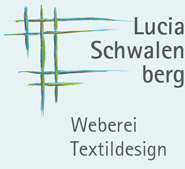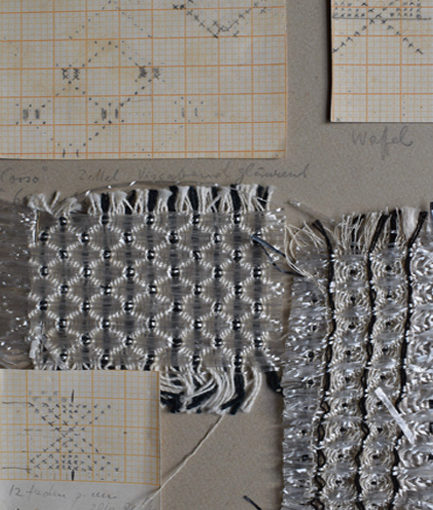Cooperation Cloth Museum Bramsche - University of Osnabrück/Textile Design
Small and fine they lie before us: the archive samples of Gunta Stölzl, master weaver at the Bauhaus. Attached to gray cardboard in Din A4, annotated in neat pencil writing, supplemented by cartridge drawings and indents. Sometimes cursory, almost fragmentary, sometimes extensively supplemented with colorits and variations. The universe and legacy of a weaver with radiance for the textile world. In Groningen, just over the Dutch border, the archive is spread out in the workroom of Stölzl's daughter Monika Stadler. Together with student assistant Mirjam Deckers, Monika Stadler sifts through, inventories and stores her mother's textile and cultural heritage. Every textile connoisseur is captivated by the sight of such archive samples. Associations arise for experimenting with materials and colorways, for patterning and collecting, for further developing and refining weaves, for altering by scaling proportions or by details of the weft sequence - ideas for series, collections, and variations.
Kerstin Schumann, museum director at the Tuchmacher Museum Bramsche, and Annette Hülsenbeck and Lucia Schwalenberg from the University of Osnabrück select the appropriate samples for the exhibition "At Second Glance - Bauhaus Fabrics as Inspiration". In cooperation with the Department of Textile Design at the University of Osnabrück, the museum pays tribute to the Bauhaus weaver on the occasion of the 100th anniversary of the Bauhaus in 2019 with this special exhibition based on Gunta Stölzl's sample archive.
Project Bauhaus Weaving Workshop in Textile Design at the University of Osnabrück
Starting from selected samples, the students in the "Bauhaus Weaving Workshop Project" at the University of Osnabrück are inspired, rework the samples, reinterpret them, adapt them to the technical conditions of the Jacquard loom in the museum. In addition to various sample looms from the department and the restored punched card jacquard with card punching machine, the newly acquired TC2 digital hand jacquard loom is used in the weaving course in the Textile Design teacher training program, making it possible to implement the samples in the limited seminar time with 14 students.
While the students work on the samples, the technical experts Wolfgang Sternberg and Hans-Heinrich Schwalenberg inspect and repair the card punching machine in the Tuchmacher Museum. It is in use for the first time in the museum's twenty-year history. For the first time in this exhibition, the museum is weaving its own beaten patterns to the existing three historical card runs.
Jacquard cards for the exhibition
After training on the card punching machine, the museum technicians Antonio Torres and Volker Leismann punch the designs of Gunta Stölzl and the Osnabrück students into jacquard cardboard in highly concentrated work. Shot after shot, the two read 400 positions each from the cartridge and transfer the binding points to perforations. They sew the card barrels together on the sewing board and hang the barrel in the jacquard prism. It's a happy moment for everyone involved when the first card runs finally produce the right pattern image, sometimes still needing to be corrected, sometimes working right off the bat.
Exclusive wool blanket collection for the museum store
The samples are selected to match the theme of woolen blankets. Woolen blankets are among the traditional products of the clothiers, who collectively produced fine woolen cloth in Bramsche for over 400 years. Today, the museum continues production on machines over 100 years old at the authentic site and is part of the Route of Industrial Heritage.
The wool fabrics developed from the Stölzl samples are available as a collection in the museum store exclusively for the opening of the exhibition. A new assortment for the museum. A new experience also for visitors, who can follow the path from the source of inspiration, the design, the card beating to the weaving and the finished product in a vivid unit. Much of the wool yarn for production is made on the museum's own machines, such as the carding machine and the Selfaktor.
The Cloth Museum: Bramsch Red for the Collection
The Clothmakers' Museum Bramsche with its historic buildings of the clothmakers' guild is idyllically located on the banks of the river Hase. In particular, the cloth produced as uniform fabrics in the bright "Bramscher Rot" made the clothiers' guild famous. The dye for the special red hue was obtained by the guild's dyer from the roots of the madder plant.
It stands to reason that Bramsch red plays a role in the collaborative project between the Tuchmacher Museum and the University of Osnabrück on Gunta Stölzl's archive samples. In addition to neutral tones ranging from white to gray, the students' sample selection includes a palette of red designs. Some of the designs will be woven on a red wool warp on the museum's dobby machine to complement the museum's jacquard and, after fulling and raising, will be made into wool blankets.
For the students it is motivating to deal with a challenging and concrete task for the 100th anniversary of the Bauhaus. And that for the Tuchmacher Museum, a few kilometers from Osnabrück, which the students appreciate from excursions and projects. The prospect of realizing the designs on the museum's Jacquard loom and presenting the resulting woolen blankets in the museum store is an additional incentive. Working in groups to develop and implement Gunta Stölzl's archive samples, the students focus on those designs that are technically feasible on the museum jacquard. These are designs in weft double for "polka dots" and a hand-drawn design by Gunta Stölzl, as well as the implementation of the museum logo in the form of a weaving shuttle. In addition, fabrics in braided twill and waffle weave, which are adapted from 14 to eight shafts due to the thread densities and number of sinkers on the museum loom.
Workshop work at the Bauhaus as a pedagogical basis
In this project, the student teachers in textile design deal with the topic of workshop work and aesthetic education in Bauhaus pedagogy. The Bauhaus as a reform pedagogical university movement with charisma far beyond the German borders stands as a beacon for fruitful pedagogical and creative work in the workshops as a basis for a sound education of the students.
Another component of the exhibition at the Tuchmacher Museum is the question of what fabrics for clothing might have looked like at the Bauhaus. While sifting through the pattern cards in Gunta Stölzl's archive, textile and clothing scholar Annette Hülsenbeck made some surprising discoveries. She found illustrations of very similar fabric patterns for the production of dresses in a 1929 issue of Vogue.
This was the starting point for pursuing the topic of "Clothing at the Bauhaus" further for the exhibition. "At second glance," Annette Hülsenbeck's research brought to light texts by Bauhaus women on the subject of fashion, fabrics, and dresses. In parallel, a group of textile students took up the theme. Under the guidance of textile artist Hiltrud Schäfer and textile designer Corinna Boknecht, they developed dress designs inspired by Bauhaus design as paper models with an experimental character.
Participating students: Canan Barcin, Julia Falke, Amelie Gieschler, Bilâl Enes Görmez, Elena Hardeenberg, Joana van der Kolk-Dölling, Karoline Meyer-Hollje, Laura Möller, Naina Reuter, Julia Schaller, Nesibe Türkaslan, Derya Tuztas, Betül Yeyet, Duygu Yildrim. (Bauhaus Weaving Workshop)
Sümeyye Asci, Fabienne Becker, Pauline Becking, Alexander Büsing, Milena Czeczor, Johanna Erwardt, Julia Falke, Jelke Kristin Färber, Lena Feldkamp, Marie Fink, Tunc Güney, Elena Hardenbeg, Gesche Hillmann, Leonie Hof zum Berge, Carolin Jankowski, Büsra Karakaya, Büsra Kayatas, Marie-Theres Kempermann, Anna-Katharina Kestel, Merve Kocaoglu, Karoline Meyer-Hollje Lara Munsch, Gülnaz Mutlu, Sabrina Müller, Carmen Norda, Carolin Polaczyk, Josefine Porompka, Neeske Caecilia Luise Remy, Annette Sander, Julia Schaller, Rieke Scholle, Susanne Schweigel, Lara Spannhoff, Charlotte Tellmann, Zeynep Uygur, Lisa Verheyden, Anja Völlmer, Zaklina Vojvodic, Anna Wandscher, Betül Yeyit, Duygan Yildirim. (Bauhaus Fashion)
Participating teachers: Dipl.Des. Lucia Schwalenberg (Bauhaus Weaving Workshop), Dipl. Päd. Annette Hülsenbeck and Hiltrud Schäfer (Bauhaus Fashion)
Photo: Archive sample Gunta Stölzl in the archive of Stölzl's daughter Monika Stadler, taken by Lucia Schwalenberg.Text: Kerstin Schumann/Lucia Schwalenberg
Hülsenbeck, Annette/Schumann, Kerstin/Schwalenberg, Lucia/Thörner, Ilka
At second glance. Bauhaus fabrics for inspiration
80 pages, numerous color illustrations
Format 14,8 x 21 cm
Bramsche 2019
ISBN 978-3-89946-302-6


